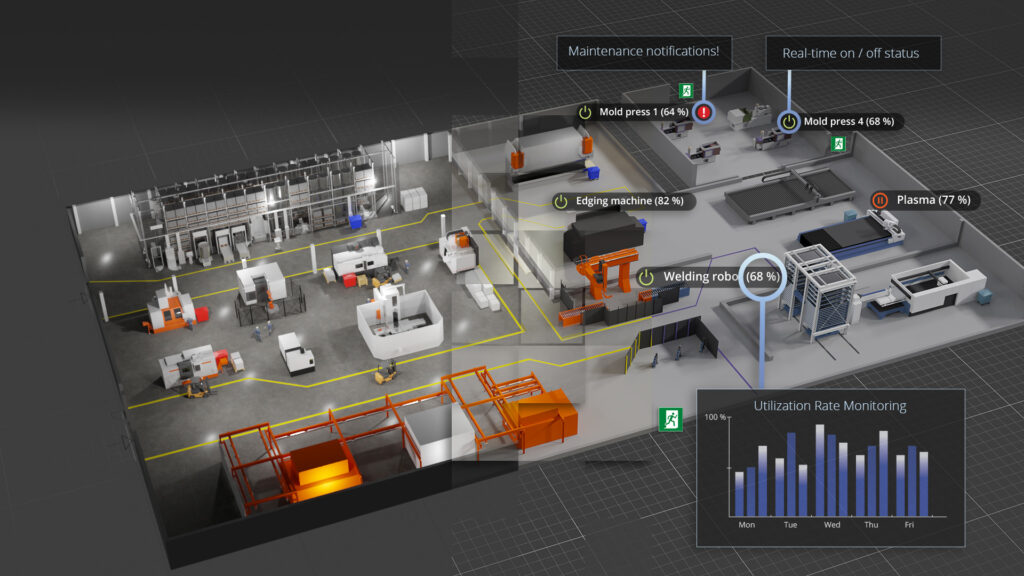What is a digital twin?

The term digital twin is usually applied to an application with the aim of digitally representing the physical world and activity, as well as creating predictions. Usually, a 3D model of the target is created and then controlled and enriched with data collected from the real world. The first definition of a digital twin dates back to the early 2000s, and the term was more widely adopted in the mid-2010s with the advent of industrial digitalization.
As use of the term became more widespread, more differing definitions were born to describe what it means in practice. On the one hand, ‘digital twin’ has described the visual representation of a process, on the other hand, a complete copy of the physical world and its operations. The data used in twins is usually harvested either from different sensors or device-based collection tools. Data is then used as the basis for mathematical calculations and predictive analytics produced by machine learning and artificial intelligence. Visually, the presentation of the information can vary from a simple Excel report to a hologram display akin to the one in Minority Report.
Digital Twins make it easier for users to understand how things work
In practice, there have been as many definitions of a digital twin as there have been actors providing and developing them. This fragmentation has not gone unnoticed around the world, and there’s been an effort to create a general definition for the term. In late 2020, the international Digital Twin Consortium published its own definition:
A digital twin is a virtual representation of real-world entities and processes, synchronized at a specified frequency and fidelity.
In all its simplicity, this is a very apt definition of what the role of digital twins is in the market. They are environments that combine the data from different systems and sources in one place and synchronize it visually with the real world. Digital twins make it easier for users to understand how things work and how various events and changes can affect the desired outcome.
The core of digital twins is the utilization and clear presentation of data from different sources to the end user. However, because there are a multitude of information sources and applications, simply collecting and presenting information doesn’t take you far, and the same solution may not work in different contexts. This is why digital twins are always a solution tailored to the end user’s premises and needs for use cases that arise from the users’ substance expertise.
The Genius Core™ technology developed by Process Genius
Our technology was developed to meet the needs of digital twins and to enable the creation of digital twins for a variety of uses. It’s divided into three main components, each of which can be used either independently or together to implement a digital twin. These components are Visualization, Data Management and Data Collection, and we’ll provide a short description of their usage next.
Visualization
Genius Core™ visualization can always be based on modeling tailored to the client’s needs, which can be anything from a simplified 3D model of the production environment to a precise model of the production environment with a physics engine. Cost-effective maintenance of the visualizations is made possible by a built-in process editor, or alternatively using the Genius Conversion™ tool for the automatic processing and conversion of design templates into the form used for visualization and the collection of desired metadata from them.
Data Management
The Data Management component offers tools to format, classify, segment and target the data presented in Visualization. This helps to filter and segment the data presented in the user interface for the needs of different user groups. This way, all the data each individual needs is available at a glance. At the same time, we ensure access to accurate and comprehensive reports and raw data to determine causality. Data Management is also where interfaces are provided for data collected for other systems (e.g. analytics services).
Data Collection
Because one of the core features of a digital twin is integration and data processing from many different sources, we decided to separate Data Collection from the rest of Data Management. In the Genius Core™ environment, the various data connections and data collection tools and their management are independent from each other and other systems. Data Collection is tasked with retrieving and receiving all the needed data from various systems and harmonizing it for the needs of Data Management. This way, the Genius Core™ technology is not limited to a specific existing hardware or data collection system to work: it can be used in conjunction with any existing or planned system.
A truly customer-oriented digital twin
We at Process Genius are pioneers in the development and implementation of Digital Twin technology. We developed the Genius Core™ technology together with our clients to meet the different needs and requirements of their Digital Twins. If you’re interested, contact us and we can discuss why we’re the best partner for the implementation of your Digital Twin.
Sources:
Definition of Digital Twin
All the information you need at one glance. One platform.
Want to know more about our solution for your organization? Please drop us a line and we’ll be in touch!